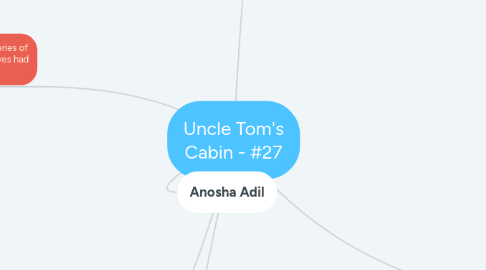
1. Uncle Tom's Cabin is a series of stories detailing how slaves had suffered.
1.1. The book was widely criticized by the South because they claimed that it portrayed the South wrong.
1.1.1. However, in her book Stowe strays from the demonization of Southerners, because she felt it would alienate them.
1.1.2. In her book, she includes two Southerners against slavery, Emily Shelby and St.Claire.
1.2. Others took to saying she hadn't been radical enough in conveying the evils of slavery.
1.2.1. She defended herself from these critics in her sequel "The Key to Uncle Tom's Cabin."
1.3. Harriet Beecher Stowe said that her book had 4 purposes.
1.3.1. To attack the sense of bitterness normally portrayed by extreme abolitionists
1.3.2. To help convert those who had been repelled by that bitterness to abolitionism
1.3.3. To instill feelings of pride, self-respect and hope to free, colored people
1.3.4. To overall create a better outlook on colored people to the world
1.4. A fugitive slave by the name of Frederick Douglas had wrote a book about his trials and hardships, 6 years before her. Harriet Beecher Stowe continued his work in enlightening people of the true horror slavery presented.
2. Harriet Beecher Stowe, herself, felt that Abraham Lincoln was taking too long to employ action against slavery.
2.1. She established schools for slaves and continued writing columns, articles, newspapers and novels.
2.2. She went to talk with Abraham Lincoln to urge him to emancipate slaves.
2.2.1. “Is this the little woman who made this great war?”
2.2.1.1. Her book laid the foundation of what led up to the Civil War.
2.2.2. Her book had changed more minds than that of any politician and adjusted the mindset of half the country.
2.2.2.1. The gag rule that held legislative bodies from speaking or considering anti-slavery topics had kept the people from understanding the true enormity of the issue, which her book helped them acknowledge.
3. Harriet Beecher Stowe was later brought up by the early feminist movement, as an example of feminist figure and scholar.
3.1. Her sisters had used her as an example in their feminist movements.
3.1.1. Isabella was a crucial member of the Women's Suffrage movement and held the annual National Woman’s Suffrage Association in 1871.
3.1.2. Catherine advocated higher education for women and established schools for them.
4. Anosha Adil
5. Harriet Beecher Stowe wrote Uncle Tom's Cabin in 1851-1852.
5.1. Just a year before, in 1850, Congress passed the Fugitive Slave Law.
5.1.1. This law made it illegal to help escaped slaves.
5.1.2. This allowed Southern slave owners to travel far into the North to reclaim their slaves.
5.1.2.1. Due to the bravery and intelligence of Harriet Tubbman and many others, some slaves were able to escape to the North and become free, but with this new law all their lives were in danger once again.
5.1.3. Stowe helped a servant of hers to a safe house in a covered wagon to save the slave from her ex-master, which inspired a scene in her book.
5.1.3.1. She was also inspired by the martyrdom of Nat Turner and wrote another book focusing on him, "Dred: A Tale of the Great Dismal Swamp."
5.1.3.2. Her book also borrowed scenes and ideas from rebellion like the Pearl incident and the Amistad Mutiny.
5.2. Uncle Tom's Cabin started as installments in an anti-slavery magazine, until she received an offer to publish it into a novel.
6. The book spread across the world and became a best seller in the United States, Europe and Asia.
6.1. It was translated into over 60 different languages.
6.2. A wave of Anti-Slavery justice swept the North.
6.2.1. This acknowledgement of the true atrocity being committed in the South gave way for the opportunity to change it.
6.2.2. It was a better anti-slavery piece than that of William Lloyd Garrison, because it wasn't harsh and demeaning, instead it was compassionate.
6.2.2.1. Stowe's compassion appealed and raised interest in the North and didn't greatly anger the South.
6.2.2.2. Stowe's magnificent writing skills humanized slavery with her two characters. Uncle Tom who is portrayed as heroic and Simon Legree who is portrayed as sadistic and cruel.
6.2.2.3. Garrison led the National (American) Anti-Slavery Society, which effectively brought in over 150,000 members but splits in the group caused it to be less efficient in its goals to abolish slavery.
6.2.2.3.1. The society started before the publication and lasted until the abolition of slavery, it is said that many prominent abolitionists had owned a copy of Uncle Tom's Cabin.
